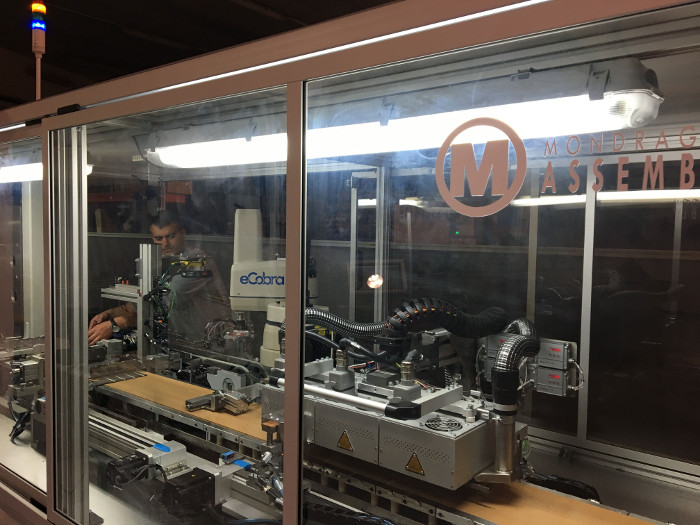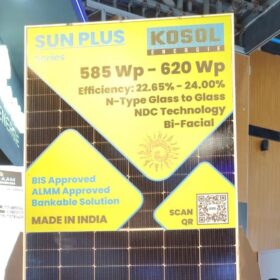Adding more busbars to a module reduces the resistive loss, increasing the power output. As materials have become cheaper and complex processes mastered, manufacturers have continually added more busbars to push more watts out of their module offerings.
The biggest power gain came with the move from three to four busbars. After four busbars, gains diminish, and the benefit of increased material consumption becomes less clear. Though some manufacturers are working with six, most see five as the practical limit, and are investigating alternative methods for the development of even more powerful modules.
MBB and shingled
First among these alternatives is multi-busbar (MBB), whereby conventional ribbons are replaced with round copper wire, usually 12 wires to a cell. The round wires can boost output by reflecting light onto a cell, which would be lost with a flat ribbon, and the technology also requires smaller grid fingers, reducing silver consumption.
MBB technology looks set for some big growth in 2019, though the technology still has questions to answer before it can reach mainstream mass production. “Conventional ribbon five busbar is still the mainstream interconnection technology this year,” explains PV InfoLink Chief Analyst Corrine Lin. “Multi-busbar is in the expansion stage, and we forecast that there could be more than 15 GW added this year. But MBB still needs to improve on yield rate and lower its production cost.”
Shingled modules, where cells are placed in an overlapping arrangement with the cells actually touching each other, have also caught the eye of manufacturers in recent years – but according to PV InfoLink, this technology still has a few kinks to iron out, as well as a patent issue causing some manufacturers to hesitate, before it can see major growth.
“We see that many Chinese manufacturers want to invest in shingled module production,” explains Lin. “But the patent issue is not clear, and since the technology is relatively new, the equipment has room for improvement. So, they are not in a hurry to invest this year.”
Lin adds, however, that there could be 5-6 GW of new shingled module capacity coming online in 2019, and that a “boom” in this technology could be a couple of years down the line.
Chinese stringer supplier Yingkou Jinchen Machinery confirmed to pv magazine that it is currently focusing its efforts on shingled module technology. At the time of printing, the company had not responded to further questions on this topic.
The supplier side
Though both MBB and shingled modules are set to gain some ground in 2019, as with innovations at every level of PV production, it is far from clear which technologies will establish themselves beyond niche markets, and many PV equipment suppliers are looking to keep their options open. For German stringer supplier teamtechnik, the future of cell interconnection remains an open question, and one in which the combination of price and performance will decide the answer.
“The leader will be the most economic – lowest materials cost, highest performance on the modules, best reliability, highest yield, and in the end the lowest production cost,” says Michael Essich, senior sales manager for solar technology at teamtechnik. “In the end, it’s the cost per watt that matters.”
The German company offers stringers that can process module combinations of up to six busbars, based on both soldering and electrically conductive adhesive interconnection.
Essich says that for now there is still a market for such tools. He notes that, with a few tweaks, teamtechnik’s stringers can also process half-cut cells as well as cells based on larger wafers (up to 161.75 mm), keeping them up to date with many of the latest trends in module production. It is this adaptability, according to Essich, that has helped the company to stay competitive.
“The standard in module production is a 5BB module, and people asking for this equipment,” he says. “Most want a machine that is convertible to different kinds of technology in the end.” And to process MBB, shingled, or other alternative interconnection technologies, teamtechnik would have to design an entirely new machine. The company is currently hesitating on this front, given the level of uncertainty over where the industry will move with regards to cell interconnection.
“We have seen a lot of technologies come into the market, only to disappear suddenly, because these were not able to compete with standard production,” says Essich. He goes on to cite metal wrap through (MWT) – a technology that has been promoted for years, but has not yet brought about the cost reductions or performance increases that could bring it to mainstream production – as an example.
“Take MWT: It’s a very nice technology, but it was a mess in terms of its yield and cost structure,” he explains. “If costs increase – because the process becomes more complex, the process yield gets lower, or material costs get higher because you need to use special materials – then it’s a dead end.”
Costs rounding up
While offering some advantage in terms of reflection, the switch to round wires that is necessary with MBB does bring some additional complexity to production, and this is one of the issues that has many manufacturers hesitating.
“The round wires are clearly a technical improvement,” explains Laura Sartore, CEO at Italian equipment supplier Ecoprogetti. “But it is also true that a smaller width of the ribbon or wires makes it tougher to ensure a good contact area, adhesion, and alignment on the cell. We don’t see any critical changes happening in the near future on the busbar technology.”
Spain-based tool maker Mondragon Assembly also warns of potential extra costs arising from MBB technology, and states that the time may not be quite right for the technology. “Right now, some manufacturers will try to go with wires, and some will stick with busbar,” explains Iñaki Legarda, energy business director at Mondragon Assembly. “Our simulations show that there is very low gain going round, and you have other alternatives to achieve almost the same efficiency levels, while keeping current technology: 0.4 mm wide ribbons or textured ribbons. Looking to the whole line, round wires imply usually an increase of bussing operations, making it a slightly more expensive process. Round wires also require thicker encapsulant which adds cost.”
Fragmenting market
It does appear that conventional five busbar interconnection is set to remain the standard interconnection technology, at least through 2019. And with ribbon innovations and other process improvements, the technology may have enough tricks up its sleeve to keep up with the alternatives and allow manufacturers to achieve their desired performance levels without the need for heavy investment in new machinery.
But innovations in other areas, particularly cell production, can dictate new needs at the interconnection stage. The latest PV cell concepts, such as heterojunction and TOPCon, are extremely sensitive to high temperatures. This can make soldering more difficult, so teamtechnik has sold several of its machines that replace soldering with an electrically conductive adhesive to manufacturers building out heterojunction lines. Switzerland’s Meyer Burger has also seen some success introducing its SmartWire technology, the production of which it outsourced to Mondragon last year.
Ultimately, rather than a new technology “taking over” from five busbar, the PV market finds itself looking at several different options gaining share over the next few years. And with module manufacturers keener than ever to differentiate their products in a crowded market, and research into specific use cases and deployment scenarios quickly gaining ground, the ones able to survive on the equipment supply side will be those who can adapt to cover the biggest spread of these.
“The market is not moving to a single technology,” concludes Ecoprogetti’s Laura Sartore. “There will be different market shares, and space for every technology: We are developing machines that [provide an] answer to specific market segments.”
This content is protected by copyright and may not be reused. If you want to cooperate with us and would like to reuse some of our content, please contact: editors@pv-magazine.com.








By submitting this form you agree to pv magazine using your data for the purposes of publishing your comment.
Your personal data will only be disclosed or otherwise transmitted to third parties for the purposes of spam filtering or if this is necessary for technical maintenance of the website. Any other transfer to third parties will not take place unless this is justified on the basis of applicable data protection regulations or if pv magazine is legally obliged to do so.
You may revoke this consent at any time with effect for the future, in which case your personal data will be deleted immediately. Otherwise, your data will be deleted if pv magazine has processed your request or the purpose of data storage is fulfilled.
Further information on data privacy can be found in our Data Protection Policy.